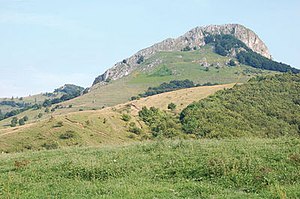Piatra Craivii
| Piatra Craivii | ||
|---|---|---|
| height | 1078 m | |
| location | Romania | |
| Mountains | Trascau | |
| Coordinates | 46 ° 12 '32 " N , 23 ° 29' 7" E | |
|
|
||
| rock | limestone | |
The Piatra Craivii (also Piatra Craivei , German stone , Gemsenstein or Sugar Loaf , Hungarian Kecskekő , 1,078 m) is a mountain on the southeastern edge of the Trascău Mountains in Romania .
The Romanian name refers to the nearby village of Craiva (Königsbach) , Piatra means stone . The German name Zuckerhut indicates the distinctive shape.
On the summit is said to be in the 1st century BC. A Dacian castle stood, the Romans called the place Apoulon . According to some historians, this fortress was the last refuge of the last Dacian king, Decebal . After the defeat of the Dacians, the Romans destroyed the castle, but then named the newly founded city Apulum (today Alba Iulia ) after it .
In 1272 the Hungarian King Stephen V had a new castle built on the summit; this was given the name Kecskés (Rum. Cetate , German Gemsenstein ). Three years later, Stephen's successor - Ladislaus IV - allowed the Dominicans to build a monastery on the castle grounds. By Matthias Corvinus , in the second half of the 15th century, the further expansion of the plant causes. A little later robber barons took possession of it. In 1515 it was destroyed.
Only a few, hardly recognizable remains have survived.
The summit of the mountain allows an unobstructed view in all directions, especially of the other elevations of the Trascău Mountains, of the Transylvanian Ore Mountains and the Transylvanian Basin .
See also
literature
- Hans Heinz Heltmann, Gustav Servatius; Transylvania travel guide , Kraft Verlag Würzburg 1993.
Individual evidence
- ↑ Reiner Heubach: The Dacian Wars of Emperor Trajan . GRIN Verlag, Munich 2002. p. 18
- ^ Friedrich Müller: The church architecture of the Romanesque style in Transylvania . Imperial-Royal Court and State Printing Office. Vienna 1858. p. 19
Web links
- Piatra Craivei as a Dacian fortress ( Memento from June 28, 2011 in the Internet Archive ) (Romanian)
- Short description at karpatenwilli.com

